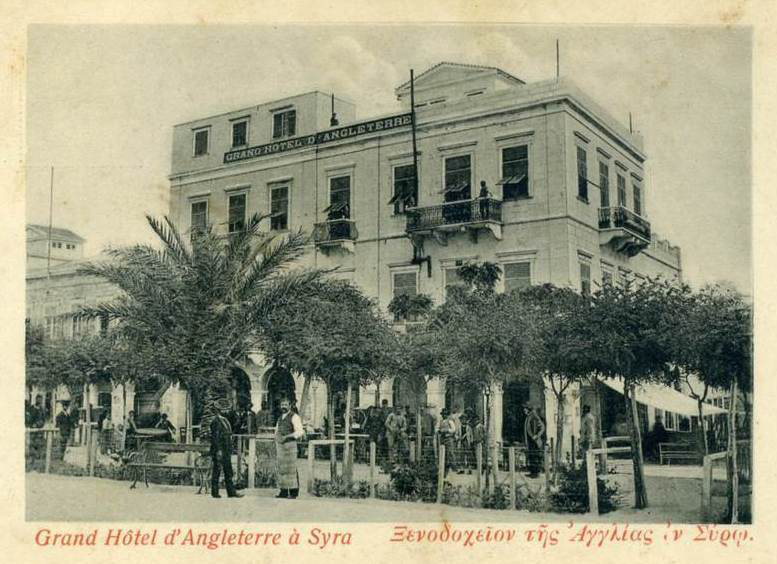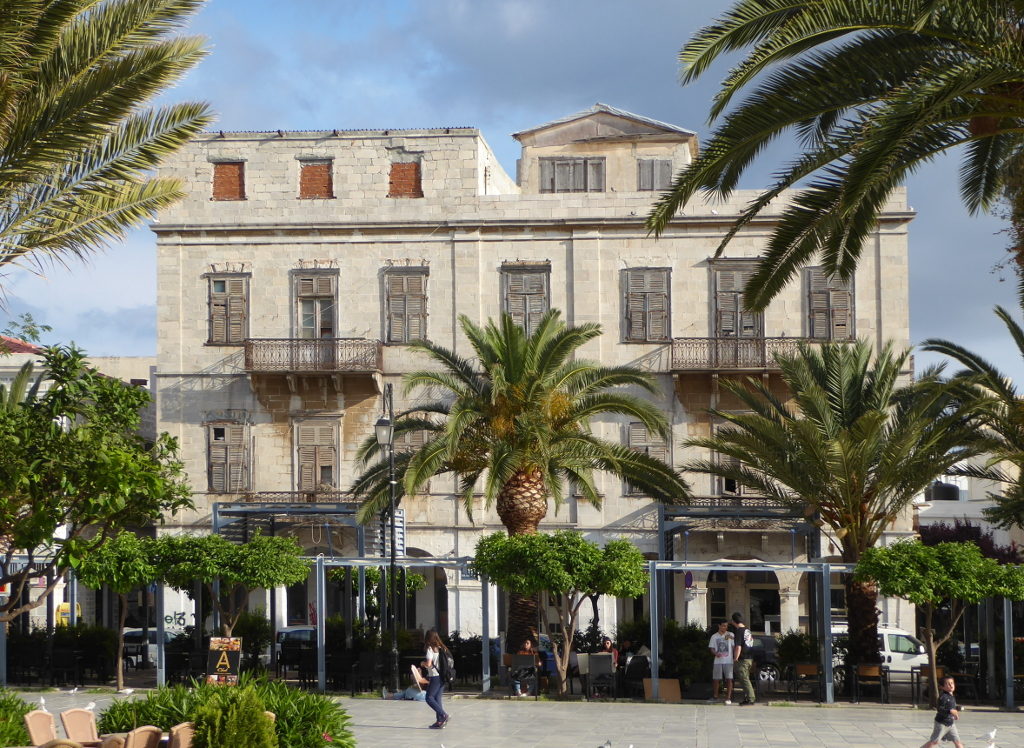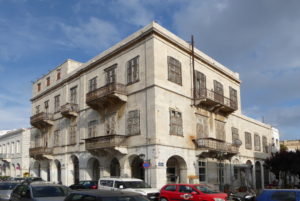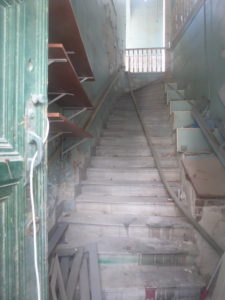Syra is almost entirely a white town, relieved now and again by a dash of yellow wash. Houses, one above another like the steps of a staircase, completely cover two hills and surround the bay in the form of an amphitheatre. One hill is crowned by the mediaeval town and its Latin church, the other by the modern Greek town and a Greek church. The background is formed by the rocky bleak mountains of the island.
Far along the quay was the fish market, with strange sights for unaccustomed eyes. Advent was soon to begin — that is, the month’s fast before Christmas — so there was any amount of octopodia in the market ready to be dried and stewed for this period. Sea-urchins, too, and bright red pinna shells, the contents of which form a substantial part of a Syriote’s meal, this morning were plentiful, besides red mullet and haddock, which to us looked more tempting.
Syra boasts of two hotels, very passable for Greece, where travellers who venture beyond the capital do not expect luxuries. We were glad enough to rest in one after the voyage, and cast about us as to how we should pass our time.
One of the hotels which Mabel talked about in her diaries was the Grand Hotel d’Angleterre in the south-west corner of the main square, Plateia Miaouli, facing the Town Hall. The building still exists but is in a derelict condition.


 No longer a hotel …
No longer a hotel …
 … and in a derelict state
… and in a derelict state
The first two-storeyed house was built in 1825, and belonged to the first demarch, Petritzi by name, and it was considered a real phenomenon to look upon . . . ever since Demarch Petritzi built his two-storeyed house in 1825 the town has adopted the Western style, and for all the world looks like a town of France or Italy.
It was in this year [1825] that Luke Ralli and others, foreseeing a future of greatness for the infant city, thought it was time to give her a name . . . Just before this a church had been built near the sea, the Church of the Transfiguration, the outer court of which was still used as a hospital for those who were obliged to live in tents; and, situated as it was amongst wretched hovels, it was a perfect beehive, where the inhabitants could swarm and sleep if they wished. In the nave of this church the magnates of the refugees held their first public assemblies, and here it was that Luke Ralli for the first time pronounced the name of the town — Hermoupolis.
An excellent street, the street of Hermes, branches away from the quay, and leads into a vast square, where in the evenings the inhabitants promenade to listen to the band. One side of this square is to be taken up by a large Hôtel de Ville; but this edifice progresses only slowly; the town authorities are careful, and only do a little now and then to it, when they have a balance in hand. Steep tortuous streets lead up one of the hills which is covered by the new town; everything is white and clean
I went to the university, which, after that of Athens, is the most reputed in Greece, and there I listened to the various classes, the lessons taking for me a curious and decidedly interesting form.
On a subsequent occasion I paid a visit to the Archbishop of Syra, Methodios by name, a man of great liberal culture and enlightenment, who does all he can to combat the almost heathenish beliefs of the Greek peasantry. He has a large house, and wears a fine enamel, set in diamonds, and was very friendly, telling us as we sipped our coffee that he had seen our party returning on muleback from an expedition into the island, and added that we had called to his mind Christ’s entry into Jerusalem.
Some of these traditions are very curious in the Cyclades, the ancient Greeks come once a year from all parts of Greece to worship at Delos, and as they pass through Syra they are purified by washing; a cliff above Hermoupolis is still called Deli , where the country folks tell you this ablution takes place, and even to-day they will reverently speak of the ‘god in Delos.’
They are vaguely aware, too, of a game called Dískos gr , and say that their ancestors used two large stone olive-presses, which stand as reminiscences of ancient fertility in Syra outside a church, as quoits .
Passing on in our rambles, we came across the theatre of Apollo, than which no better theatre exists in modern Greece. Even Athens cannot boast of such. Curiously enough the piece advertised for that evening was The Pirates . I could not help thinking how short a time it was since the pirates had been a subject for more serious thought in Syra.
Beyond the theatre and the church is the west end of Syra, where stately mansions are built on the top of a cliff, overlooking the sea. These houses of Hermoupolis, like those of Athens, rejoice in a superabundance of marble. There are very few islands of the Cycladic group which do not produce marble, and at the north end of Syra there is abundance of it. Each balcony is supported by marble lions or griffins; the steps, the facings and window-cases of all the houses are of marble.
the small space of waste ground between the old town and the new is rapidly giving way to a mass of houses and factories; for with a central depôt for the Eastern Telegraph, and steamers of every company calling here, Syra cannot be expected to stand still.
It is true that the existence of a third city is proved by the ruins which have been found whilst building Hermoupolis. One inscription tells us of the existence of a temple of Isis, where now stands a great pandopoleíon gr (general shop), but it is highly probable from these inscriptions that the city, on the ruins of which Hermoupolis has risen, was of a more recent date,
at the ruins of the city near Delle Grazie another inscription has been found, which was put up to Miagnas, a priest of Poseidon, and Amphitrite in the temple there. It is very probable that the inhabitants deserted this spot and went to the better harbour, for the bay of Delle Grazie is shallow, and exposed to the western winds. There are numerous traces of walls and graveyards at this spot, which is still called Poseidonia, and beyond, on the other side of the bay, are the scanty ruins of another town still called Phoenichos. Here is a little solitary church, into the walls of which bits of marble have been let, and the flat land around is covered with bits of broken vases. In the sea, too, are ruins of some buildings, called now the little monastery, about which I can make no suggestion.
On the way to Delle Grazie we saw many of these country seats, especially at Talanta, where money has had a veritable struggle with nature, and been fairly successful.
One afternoon I strolled up the hill, to inspect the town of ‘Upper Syra,’ as it is now called, where the mediaeval Roman Catholic settlement still exists; here everything is old world, and the inhabitants seem utterly unconcerned about the busy life in the lower town. The houses are like steps, one above the other; and the steep narrow streets, foul with refuse and tenanted by pigs, lead up spiral fashion to the convent and church of St. George, which crowns the hill. From the terrace in front of the edifice a fine view is obtained over the sea, dotted with Cyclades as far as the eye can reach; to the right is a brown stony valley, characteristic of Syra, and on the brow of the opposite hill a newly-fledged Greek convent seems as if it looked with contempt on the Roman Catholic town, as much as to say that its reign is over.
Mabel’s Chronicle entry: We packed a box of our spoils for England and this afternoon, 22nd [Saturday, March 18841, I rode and the others walked to Ano or Upper Syra, a hideous place with a view over this barren island.
She was a young lady of considerable sentiment I imagine, for she carried in her hand a pretty flower which grows on the hills under the acanthus bushes, called ‘patience’ by the Greeks ( ipomoní gr ), ‘For when I look at it,’ she concluded, ‘I feel strengthened to bear my lot patiently.’
We saw hardly any signs of habitation on our way until we came to a low whitewashed cottage, where lives, high up on the mountain-top, a tottering old man ninety-five years of age. He looks after a small garden, and whenever he wants anything he walks into Hermoupolis to do his shopping.
When we left him, I asked our muleteer if people frequently lived to be so old at Syra. ‘Yes,’ was the reply, ‘an old woman died at one hundred and thirty only a short while ago; in former years people lived so long that the aged had to be thrown down a mountain cliff which is still called Geronsi ( géron gr ).’
We passed close to a cave, reminding one of the habitation of a Cyclops, where 2,000 sheep and goats are kept at night, which wander over the mountain-side by day and gnaw the aromatic scrub.
After a ride of four hours we came to our destination, a long strip of marble which runs into the sea like a bird’s beak, and shelters a little bay from the fury of the north wind; it is almost at the extreme northern point of the island, and was in ages long gone by a favourite resort of mariners during stormy weather. This tongue of marble is part they are prayers for good voyages, and thanksgivings for safety made by those anchoring in this little bay in time of tempest, both for themselves and their friends.
Taking the pagan ones first, we find most of them to be simply names. Mithres of Sardis is the only one which conveyed anything to our minds, for Mithres is a name found on Sardian coins. Again we have the names of those who used this tongue of land as a point for observation ( Skopi tou Áthinobíou tou navklírou gr ) and various others, reminding us of the passage in Lucian which says, ‘It is necessary first before sailing to go to some point to observe if the wind is favourable.’ Then again we have epigraphs in memory of friends, perhaps those who had been lost at sea; prayers for good voyages for the writers and their friends; thanks for preservation from shipwreck, principally to Asclepius; for example, ‘We in the Milesian ship, thank Asclepius;’ and lastly, farewells to friends. Many of these epigraphs refer to a temple of Serapis, which must have stood on this point, though all traces of it have been obliterated.
We next turned to consider the Christian writings, which are more minute in their information about men and ships, and are written in help us! Lord save us!’ &c., and then give the name of the supplicant, his father’s name, his country, sometimes that of his ship, and occasionally, though rarely, they mention the month and year. There are about 100 of these, affording a curious collection of names, occupations, and countries; sailors, captains, one novitiate, deacons, a soldier, a centarch, Commander Stephen, chiliarch of Asia with his aurarii, fellow-citizens, &c., showing what a popular place of resort once was Grammata Bay
After a hurried lunch among the epigrams, we started on our weary way back across the mountains, returning, as our herdsmen affirmed, by a somewhat shorter way close to a church called Syringa, where is a fountain of healing water which is bottled and sent abroad. A popular distich of Syra, which our companions sang, tells us that for health all that is required is ‘some water from Syringa, grapes from Chryse, and a sprig of basil from Cyparyssa.’ Chryse and Talanta certainly seem at present to be the only places on the island where grapes will grow, and this with difficulty. Doubtless this distich is of a not very modern date, and may refer to the ancient fertility. As for the basil from Cyparyssa, I never saw any
